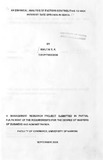| dc.description.abstract | This study sou,ght to identify the factors that contribute to the high interest spread in Kenya and also to quantify the impact of these factors on interest rate spreads.
Monthly data on the change in overall consumer price index (inflation), nominal treasury bill rate, inter-bank rate, the ratio of operating costs to total income, unremunerated required reserves of banks, default risk (measured by the non-performing loans to total loans ratio) and the Herfindahl - Hirschman index (HHI) for banks were used as explanatory or independent variables.
A multivariate interest rate spread model was formulated to test the significance of each of the independent variables as determinants of banks' spread. The monthly average data of the variables were regressed against the percentage of interest rate spread per month as the dependent variable. The study covered the period 1993:1 to 2002:12 when the banks' interest rate spread was the highest in Kenya.
Secondary data was obtained from various published sources and analysed by use of multiple regression modelling. The Pcgive Statistical Package was used.
The results of the study indicate that the Treasury Bill Rate, Operating Cost to Total Income Ratio, Unremunerated Required Reserves, Default Risk and Herfindahl-Hirschman Index are key variables determining banks' interest rate spread in Kenya.
An increase in Operational Expenses to Total Income Ratio leads to an increase in the banks' interest rate spread. Increase in Unremunerated Required Reserves has similar effect in banks' interest rate spread. Similarly, increases in the Default Risk, measured by the Non-Performing loans to Total Loans Ratio, lead to increase in banks' interest rate spread. The Herfindahl - Hirschman index, measures the level of competition in the banking sector. According to the study, an increase (decrease) in the Herfindahl - Hirschman index results in an increase (decrease) in the interest rate spread.
The results also show that the Treasury bill rate and the inflation rate variables, which were insignificant in the long run, were however significant in the short run but with different signs at | en |

